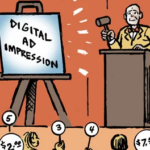Retail media has taken over the business end of the retail industry.
Advertising revenue is attractive for nearly any company with strong first-party data, especially grocery stores and pharmacies that carry many of the best-known consumer brands.
But with advertising, there are always trade-offs.
Recent changes to the offline and online shopping experience – from locked shelves in stores to keyword-based online grocery search trends – are unpopular with consumers.
But these changes appeal to retailers as they prioritize their data-driven advertising businesses, according to three marketers for large grocery and pharmacy brands who spoke with AdExchanger.
Are retailers locked in?
The experience of brick-and-mortar shopping has deteriorated in many places, but particularly in pharmacies and grocery stores that have erected plastic barricades or installed locked cabinets for certain products. Customers must press a button to summon a store employee to get the item.
One rationale for the rollout of in-store product prisons is a supposed spree of theft over the past few years. But that’s not the full story.
As Bloomberg reported earlier this year, “shrink,” which is the retail term for product loss due to damage, human error or shoplifting, has remained steady, while incidents of merchandise stolen in transit has soared. (This is the organized crime method of stealing from warehouses, delivery trucks and trains.)
Another reason for the barricades, one major snack brand marketer speculated to AdExchanger, is the expansion of retailer private label lines and of data-driven shopper marketing programs.
Next time you visit a major pharmacy chain, said one marketer for a well-known cosmetics brand, take note of the fact that brand-name items require an attendant. Meanwhile, nine times out of ten, there’s a nearby private-label alternative that’s not behind a gate.
Isn’t it strange, said another marketer for a household cleaning product, that private-label items are apparently immune from theft? This marketer’s product is also now often gated in many locations.
From the retailer’s perspective, locked cabinets are justified because of shoplifting, but there are also knock-on benefits to their shopper marketing biz. Brands will pay to get out of the lockbox, such as by buying an end-cap aisle display, and retailers see an increase in their own private-label sales, which is more profitable for the store.
Seemingly lost, however, is that shoppers hate the changes that retailers have made.
In October, Manmohan Mahajan, CFO of Walgreens Boots Alliance, told investors that store sales in Q3 dropped 1.7% from last year, but that the company made up the difference with refinements to its “pricing and promotion strategy” and an increase in private-label sales.
Walgreens attributed its store sales decline to general consumer malaise – yet Amazon’s pharmacy business is booming. During Amazon’s Q2 earnings call in May, Evercore analyst Mark Mahaney asked about the unexpected uptick.
“If you walk into pharmacies in cities today, it’s a pretty tough experience with how much is locked behind cabinets, where you have to press a button to get somebody to come out and open the cabinets for you,” Amazon CEO Andy Jassy responded.
Last month, during Amazon’s Q3 call, Jassy touched on the topic during his opening remarks, noting Amazon’s pharmacy business doesn’t “require customers to make trips to forlorn physical venues with much of the selection behind locked shelves.”
Walmart, for its part, is considering a novel approach to make trips to its stores less forlorn. Although it’s expanded its in-store pharmacy barricades, it may offer a new benefit for its Walmart+ loyalty program in the form of a button in its app that unlocks store shelves without an attendant.
That’s one way to resolve a self-inflicted problem while also juicing its data and subscription businesses. Yet it’s also an example of a data-driven advertising business creating the wrong incentives. The idea shouldn’t be to create a problem that can solved by paying a membership fee.
We may see Walgreens and other brick-and-mortar pharmacy chains continue to suffer losses in sales, not because of an economic downturn but because they deliberately introduced friction into their in-store shopping experience. To make up the losses, they turn to high-margin advertising and private-label sales – further incentivizing the installation of barricades and the prioritization of shopper marketing revenue.
Digital isn’t always better
Plastic product prisons aside, there have been other recent changes to how people shop that some customers don’t care for. These, too, are exacerbated by retail media growth imperatives.
Sometimes, these changes are framed as a customer benefit.
For instance, digital overlays on beverage coolers in pharmacy chains were positioned as a new fun feature with utility. But drill down, and it’s actually about creating data-related opportunities for the retailer’s ad business.
In-store digital technology is a hot topic in the retail biz. Things like digital price tags on shelves are exciting for retailers because they allow for targeted promotional offers and the ability to attribute retail media conversions.
Yet, do shoppers want this stuff?
Probably not, if experience tells us anything.
Search mis-incentives
Another change to grocery and pharmacy shopping is related to online search habits.
Now that retailers operate data-driven ad auctions, they are heavily incentivized to allow, or even increase, conquest marketing, which is when a rival brand is allowed to bid directly on its competitor. Companies are thus also forced to spend defensively on their own names and key terms. Walmart began allowing conquesting ads this year, and others will no doubt follow suit.
When an Amazon shopper searches for “Duracell batteries,” for example, or “Nathan’s hot dogs,” they want that specific item, but they understand Amazon will show them third-party sellers and other brands, too. That’s a typical search experience.
But would a shopper feel the same way if they’re conducting a search on Albertsons.com and being directed to brands other than the specific one they searched for?
That’s a harder question to answer. But the problem is that the interests of the retail media business are completely unaffected by the answer.
And online search advertising will only further complicate the picture for retailers.
Go search for “vegan cereal” on Walmart.com. Dollars to doughnuts, you will see a sponsored ad for a non-vegan cereal atop the results page.
From the retail media perspective, that’s a no-brainer. If there are more bidders per impression, bigger brands will pay more for people who search for, say, “vegan” as a proxy for their interest in healthier or organic products.
On the other hand, this could be confusing for shoppers. Those sponsored listings may contain words like “vegan-friendly” or even include the word “vegan” itself as metadata highlighted in the search result for a product that isn’t actually vegan.
That would never happen in a store. If a physical shopper asked a store worker to point out the vegan cereal, and that worker affirmatively suggested a brand they knew wasn’t vegan, they’d probably get a reprimand.
Put another way, retailers have customers. Platforms have users. And the line is starting to blur.
But retailers must always have a shopper-first mentality. At times, that may mean having to deprioritize their retail media business, which tends to think in terms of users, clicks and ROAS performance, rather than the shopper experience.
Otherwise, retail media might just ruin retail.
















